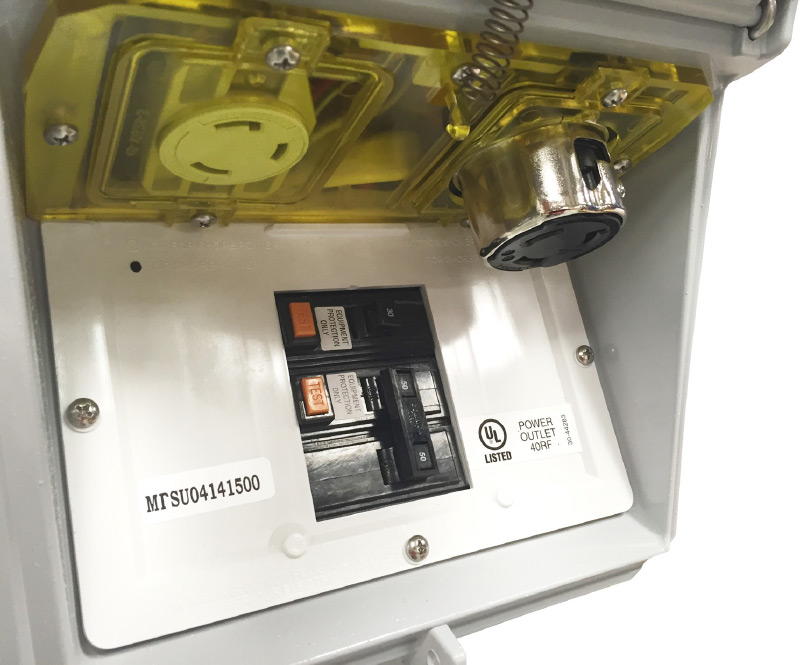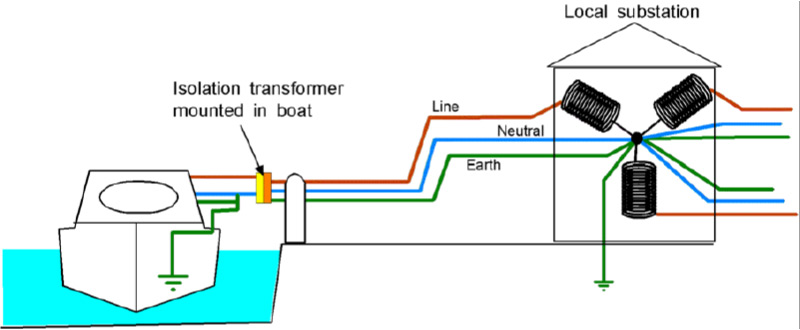ELCI stands for Equipment Leakage Interrupter. They are being installed in marinas across Washington State. Under the WAC 296-46b. Anytime work, upgrades to existing power supplies in marinas, docks or in new construction. Marinas must comply with the NEC code 555.3,which states. ” Ground-Fault Protection. The over current protective devices that supply the marina, boatyards, and commercial and noncommercial docking facilities shall have ground-fault protection not exceeding 30 MA.”
It is required to keep loose or stray current out of the water eliminating the shock hazard that occurs when a swimmer or a person falls in the water. The body can create electrical path I.E. between two boats or a ground source causing the person to become incapacitated and drowned.
Eventually all docks and marinas will have ELCI breakers built into the shore power system.
ELCI’s are in two locations in the marina, one is at the pedestal that serves the vessel and the other is at the transformer serving all the boats sharing the same power source. All vessels on the same line together must hold a maximum of 50 milliamps. A single boat can bring down the whole dock and a marina manager must be sent out to reset the breaker for the entire dock. Each pedestal has it’s own breaker made to trip at 30milliamps slightly lower in hopes that a boat will not trip the whole dock.
How do ELCI breakers work?
An ELCI breaker works a lot like a GFCI breaker you have at home. A GFCI trips at 5 milliamps of current detected over the ground line and must be reset.
ELCI breaker trips at 30 milliamps a slightly higher value and looks at the black hot and white natural wires coming in and out of the shore power plug. These two wires should be in balance with one another. Since the power coming into the boat over the back hot should be the same amount leaving the boat over the white neutral wire. Any unaccounted-for electricity must be going someplace else and back to ground via the water or the green ground safety wire.
If you happen to trip your ELCI breaker at the pedestal. Turn OFF all your AC breakers on your AC panel including the main shore power inlet breaker. Unplug your shore power cable from the pedestal and the boat. Reset the ELCI breaker then plug in the shore power cord into the pedestal if the breaker trips it’s most likely the power cord. Next move to the boat side and plug into the boat if it trips it’s most likely the shore power inlet or boat end of the cable. Next go to the master breaker and turn it on if it trips then there is something going on and most likely time to call an ABYC tech. If all goes well start turning on the branch circuit breakers turn one breaker at a time if ELCI trips the problem is on that circuit.
Common causes of ELCI failure are terminal strips, household appliances that are not for marine use, hot water tanks, improperly installed inverter/chargers and just old outdated electrical wiring.
If you can not resolve these issues easily it is likely time to call in an ABYC electrician. determine the best way to fix your problem. For some boats it is most cost effective to install an isolation transformer.
What is stray current?
When you plug a boat into shore power you are tying all the electrical systems together via the green ground wire. The ground wire is daisy chained to all the boats on the same line via. The ground wire is terminated at the power source being the transformer that serves all the boats on the line. It is important to remember that the AC Ground wire is attached to the DC negative bus and the bonding system. Together this is called Grounding. All electricity is looking for a way back to the original power source. When an electrical system becomes compromised due to poor wiring a vessel can leak current into the water via the bonding system or other compromised piece of electrical equipment. The stray electricity is looking for the easiest way back to the power source. Via earth ground or it can be another vessel connected to the same electrical system via the shore power connection.
Stray current is not limited to AC current and can just as easily be DC current leaking from a boats battery system. DC current can be very damaging to the running gear eating props, rudders and shafts at an alarming rate. DC stray current acts with electrode and anode taking a molecule of metal from one place and putting it some place else. AC current tends not to do as much damage. The alternating current electron moves back and forth within the conductor. So AC current tends to leave the metal alone. Not to say that there hasn’t been a lot of damage caused by both types of stray current.
Boats have been required to have a galvanic isolator installed between ground wire and the shore power system for years. A galvanic isolator is a DC blocking diode. Normally a black box located near the shore power inlet with the green wire going in one end and out the other. If your boat is not equipped with a galvanic isolator, I highly recommend getting one installed.


















